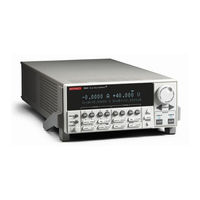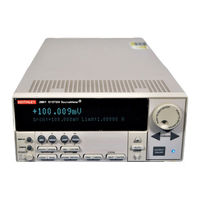User Manuals: Keithley SourceMeter 2612 System SMU
Manuals and User Guides for Keithley SourceMeter 2612 System SMU. We have 4 Keithley SourceMeter 2612 System SMU manuals available for free PDF download: Reference Manual, User Manual
Keithley SourceMeter 2612 Reference Manual (562 pages)
System SourceMeter 2600 series (SMU)
Brand: Keithley
|
Category: Measuring Instruments
|
Size: 14.05 MB
Table of Contents
-
-
-
Introduction26
-
-
Power-Up
38-
Beeper39
-
-
-
Introduction
51 -
-
-
Operators94
-
Precedence96
-
Branching98
-
Loop Control99
-
-
-
-
-
-
Guarding116
-
Noise Shield117
-
Figure 3-16120
-
Safety Shield120
-
Figure 3-18121
-
-
Test Fixture123
-
Floating a SMU124
-
-
Basic Operation
129 -
Overview
130 -
-
Warm-Up134
-
Auto Zero134
-
NPLC Caching134
-
-
Measure Only
139 -
Sink Operation
140 -
-
Ohms Ranging140
-
Ohms Sensing141
-
Sense Selection142
-
-
-
Sweep Operation149
-
Overview
150-
Section Overview150
-
Sweep Overview150
-
-
Sweep Functions
155 -
Running Sweeps
157-
Front Panel157
-
-
-
-
-
Overview
176 -
-
Reading Buffers179
-
Buffer Status182
-
-
Compliance Limit
188-
Overview188
-
Sweep Waveforms
189 -
Pulse Concepts
208
-
-
In this Section:211
-
Overview212
-
Initialization213
-
-
Accessing Nodes215
-
System Behavior215
-
-
-
-
Triggering
236
-
-
GPIB Operation
250-
GPIB Standards250
-
GPIB Connections250
-
Overview250
-
-
Primary Address252
-
Terminator253
-
-
-
-
LOCAL Key256
-
-
-
-
TSP-Link Nodes264
-
Reading Buffers265
-
-
Delay Function277
-
-
Factory Scripts
379
-
-
-
Display Features
416-
Display Screen416
-
Display Messages418
-
-
Input Prompting
421 -
LOCAL Lockout
424 -
Load Test Menu
424 -
-
Key-Press Codes427
-
-
-
-
Warm-Up Period432
-
Introduction432
-
Line Power433
-
A Specifications433
-
-
Introduction470
-
Reading Errors499
-
-
Common Commands
505-
D Status Model509
-
Overview510
-
Error Queue536
-
Introduction539
-
Test System Used540
-
Rate555
Advertisement
Keithley SourceMeter 2612 Reference Manual (594 pages)
Brand: Keithley
|
Category: Measuring Instruments
|
Size: 7.29 MB
Table of Contents
-
-
Introduction28
-
Power-Up39
-
Beeper41
-
Main Menu45
-
Menus45
-
Basic Operation138
Keithley SourceMeter 2612 User Manual (114 pages)
Series 2600
System SourceMeter Instruments
Brand: Keithley
|
Category: Measuring Instruments
|
Size: 4.02 MB
Table of Contents
-
-
Topic Page
15
-
-
-
-
-
User Scripts48
-
-
-
-
Advertisement
Keithley SourceMeter 2612 User Manual (108 pages)
Brand: Keithley
|
Category: Measuring Instruments
|
Size: 3.66 MB
Table of Contents
-
-
-
-
-
User Scripts50
-
-
-
-



